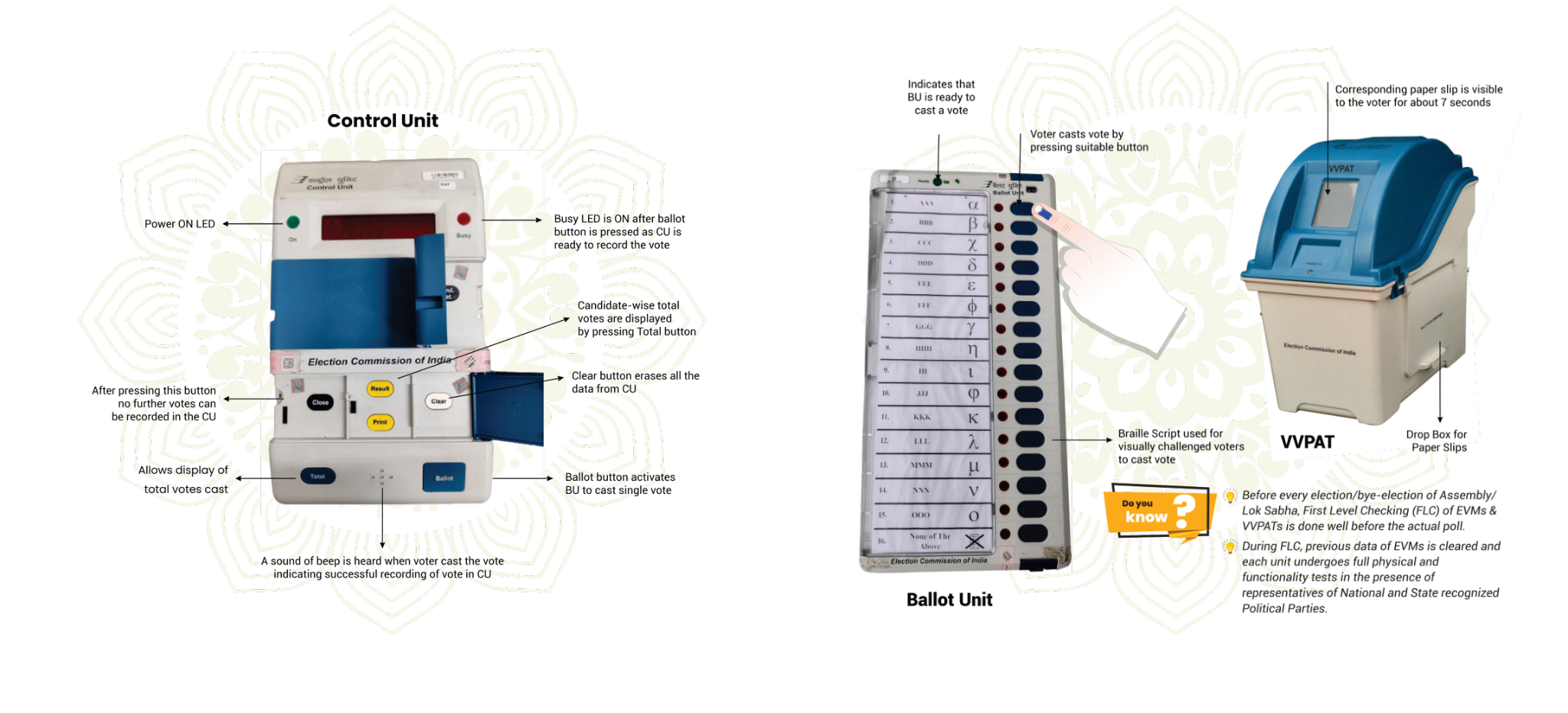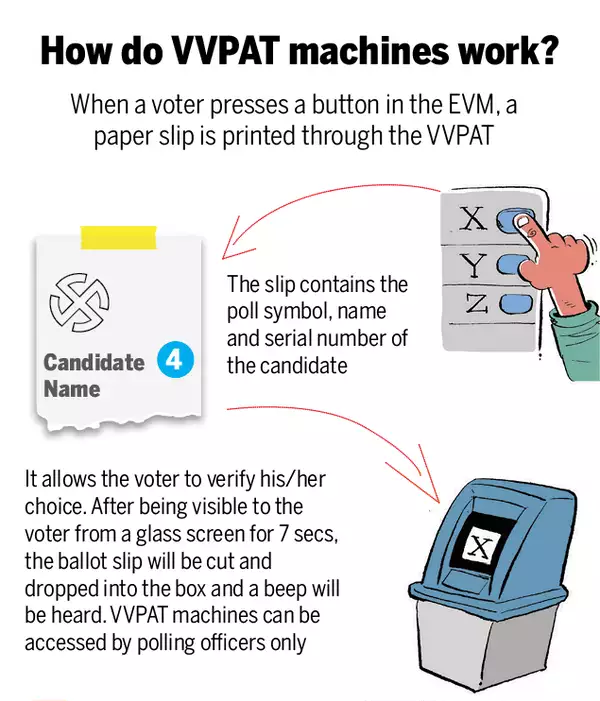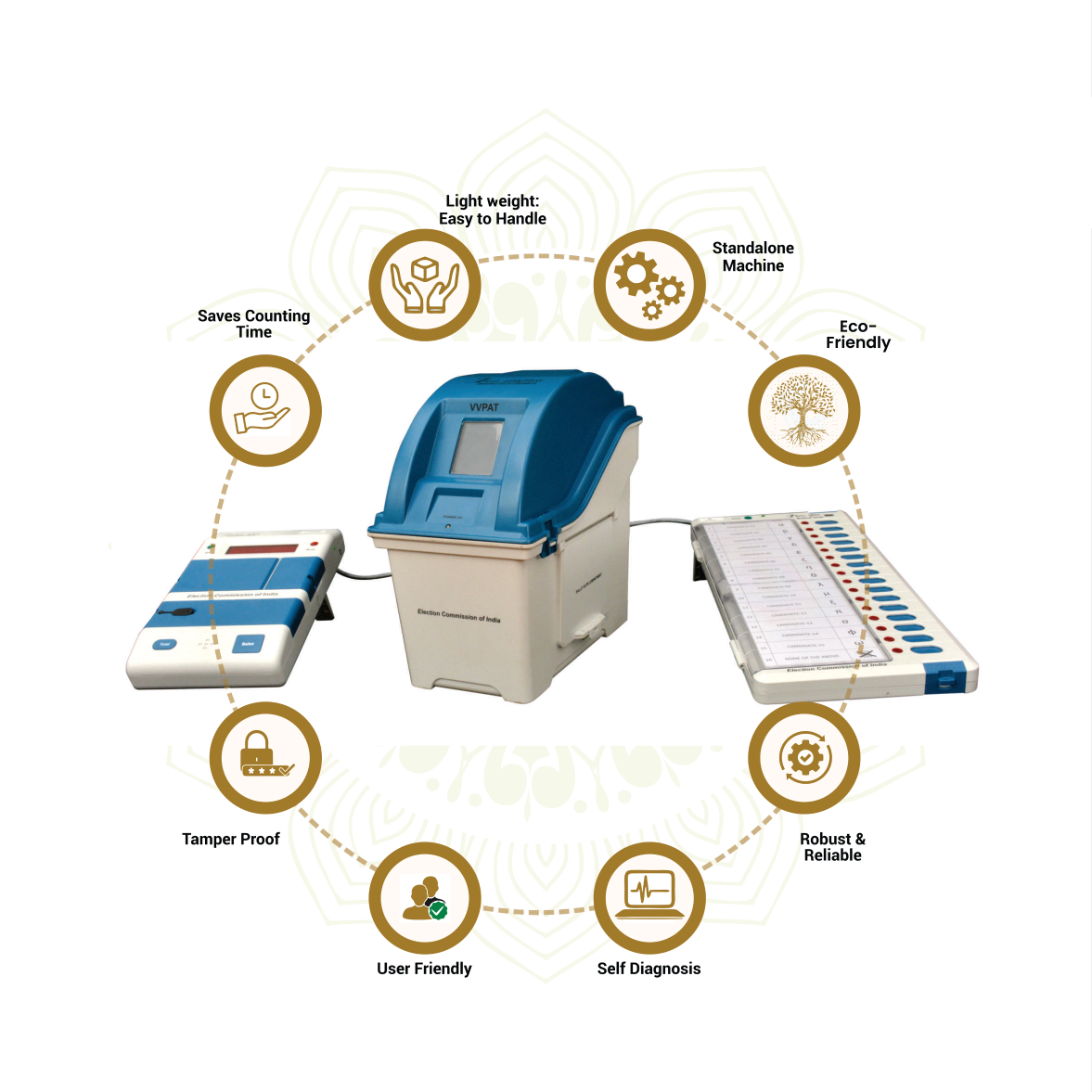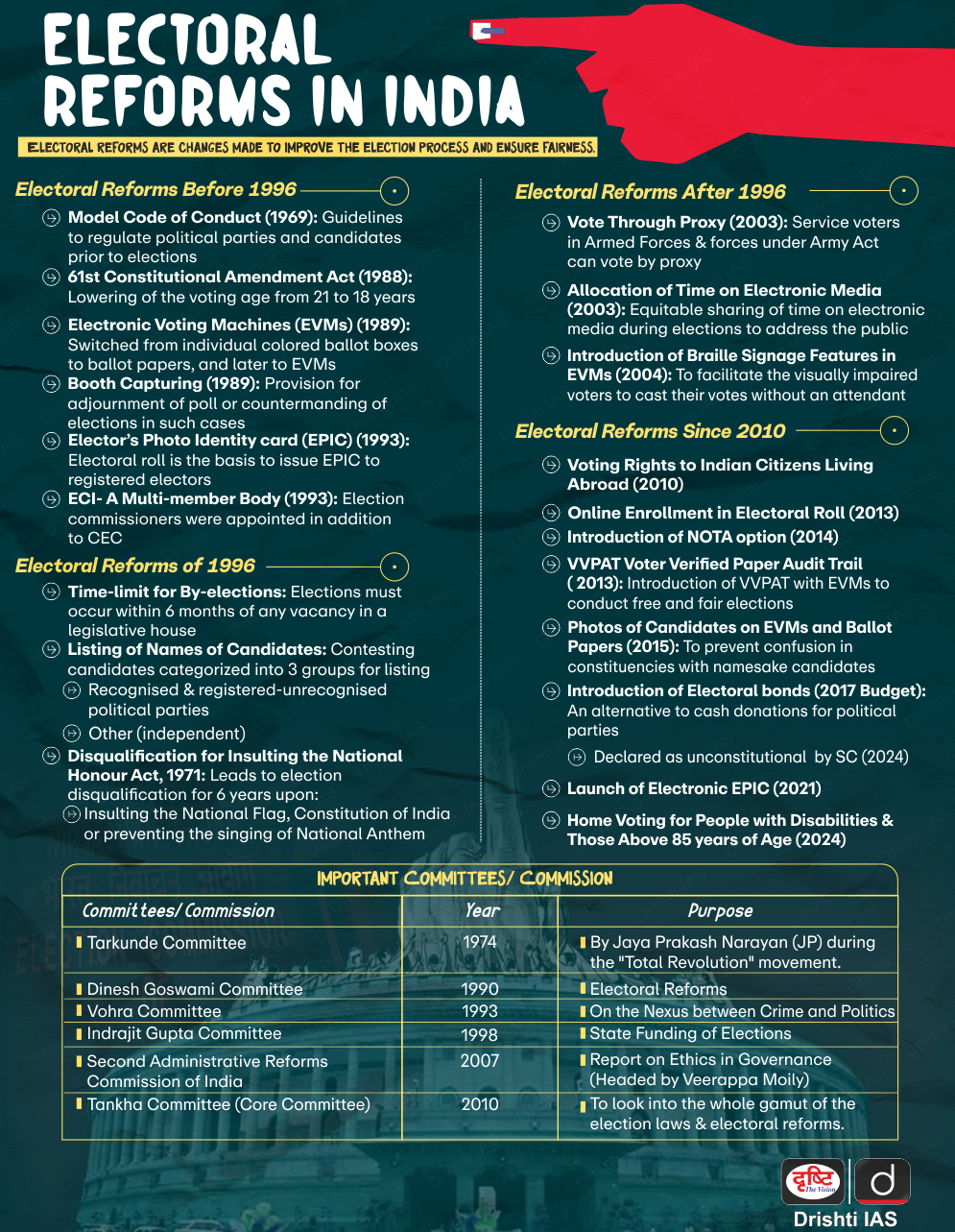Governance
SC Upholds EVM and VVPAT System
- 28 Nov 2024
- 11 min read
For Prelims: Supreme Court, Electronic Voting Machines (EVMs), Voter verifiable paper audit trail (VVPAT), General Elections, Parliament, State Legislature, Panchayats, Municipalities, Bharat Electronics Limited (BEL), Electronics Corporation of India Limited (ECIL), Standardisation Testing and Quality Certification (STQC), EVM Management System, Election Commission.
For Mains: Electoral Reforms in India, Transparency in Elections.
Why in News?
Recently, the Supreme Court (SC) dismissed a PIL which sought re-introduction of ballot papers in place of Electronic Voting Machines (EVMs) and Voter verifiable paper audit trail (VVPAT).
- SC emphasized that EVMs are often questioned only in the wake of electoral losses, reaffirming confidence in their mechanism and the safeguards in place.
What is the Controversy Regarding EVMs?
- Controversy: Some political parties have claimed EVM tampering before elections, especially after losing, raising doubts about their reliability.
- In 2009, the losing party in the 2009 General elections raised concerns about the reliability of EVMs.
- Following the conclusion of voting in the 2019 Lok Sabha elections, the opposition parties have again raised the issue of integrity of EVMs.
- In 2020, the controversy resurfaced after assembly elections in five states.
- Election Commission's Response: The Election Commission has consistently defended the reliability of EVMs citing studies by technical experts to assert that the machines cannot be hacked or tampered with.
- Supreme Court Response: SC held that a number of technical safeguards and administrative protocols with stringent checks have been put in place to prevent EVM tampering and rejected the plea for a return to ballot papers as unsound.
What are EVMs and VVPATs?
- About EVMs: EVMs are portable instruments for the purpose of conducting elections to the parliament, state legislature and local bodies like panchayats and municipalities.
- It is a microcontroller-based instrument and is designed for a single post and a single vote.
- Components of EVMs: An EVM is designed with two units i.e., the control unit and the ballot unit. These units are joined together by a cable. It ensures that the polling officer verifies your identity.
- Control Unit: The control unit of the EVM is kept with the presiding officer or the polling officer.
- Ballot Unit: The balloting unit is kept within the voting compartment for electors to cast their votes.
- Evolution of EVMs in India:
|
Year |
Event |
|
1977 |
Concept of EVM conceived. |
|
1979 |
Prototype developed by ECIL, Hyderabad. |
|
1980 |
EVMs demonstrated by the Election Commission in August ; directives issued under Article 324. |
|
1982 |
EVMs used in Kerala's Parur by-elections; legality challenged by the SC. |
|
1988 |
Representation of People Act amended (Section 61A) to empower ECI to use EVMs. |
|
1990 |
The Dinesh Goswami Committee recommended EVMs as technically sound and secure. |
|
1998 |
EVMs used in 16 Assembly elections. |
|
1999-2000 |
Expanded use in 46 parliamentary seats (1999) and Haryana Assembly polls (2000). |
|
2001 |
Full use in Tamil Nadu, Kerala, Puducherry, and West Bengal Assembly elections. |
|
2004 |
EVMs used nationwide in Lok Sabha elections. |
|
2013 |
VVPAT was introduced via amendment to the Conduct of Election Rules; first used in Nagaland by-election. |
|
2019 |
First Lok Sabha election fully backed by VVPAT. |
- About VVPAT: VVPAT enables voters to confirm that their votes are recorded as intended.
- When a vote is cast, a slip showing the serial number, candidate's name, and symbol is printed.
- It is visible through a transparent window for 7 seconds before being automatically cut and stored in a sealed box.
What are the Various Safeguards to Ensure EVM Integrity?
- Technical Safeguards:
- Functionality: EVMs consist of a Control Unit (CU), Ballot Unit (BU), and VVPAT.
- VVPAT allows visual verification by printing a slip with the candidate’s name, symbol, and serial number.
- Microcontroller Security: The microcontrollers are One-Time Programmable (OTP) and cannot be altered after manufacturing.
- Any physical attempt to access the microcontroller disables the machine permanently.
- Manufacturing: Only trusted Public-Sector Undertakings (PSUs) like Bharat Electronics Limited (BEL) and Electronics Corporation of India Limited (ECIL) manufacture EVMs.
- Standalone Operation: EVMs operate without wired or wireless connectivity, eliminating remote manipulation risks.
- Advanced M3 EVMs (Post-2013): It features tamper detection to disable the machine if accessed unauthorizedly, and mutual authentication to block unauthorized devices.
- EVM Management System (EMS 2.0): It tracks and manages EVM movements, ensuring security during transportation and storage.
- Functionality: EVMs consist of a Control Unit (CU), Ballot Unit (BU), and VVPAT.
- Administrative Protocols:
- First-Level Check (FLC): Visual inspection, cleaning, and functionality tests are conducted by engineers from BEL/ECIL.
- Dummy symbols are loaded for mock polls to verify performance.
- Randomised EVM Allocation: EVMs are randomly allocated to assembly constituencies and polling stations to avoid predetermined assignments.
- Randomisation is done using the EMS 2.0 system in the presence of Election Commission observers.
- Candidate Setting: Candidate details in EVMs, called 'Commissioning', are loaded only after the final candidate list is available.
- Mock Polls are conducted at multiple stages, including before polling day, to ensure accuracy.
- Counting Day Procedures: EVMs are brought to counting tables under CCTV surveillance.
- Random cross-verification of VVPAT slips from 5 polling stations per assembly constituency is conducted.
- EVM Storage Protocols: Stored in strongrooms with single entry/exit points, under CCTV and armed police surveillance.
- Double-lock systems are employed, with keys held by separate officials, and GPS-tracked vehicles are used to transport EVMs after polling.
- Periodic Inspections: District Election Officers conduct monthly inspections of EVM warehouses to ensure secure storage conditions.
- First-Level Check (FLC): Visual inspection, cleaning, and functionality tests are conducted by engineers from BEL/ECIL.
What are Advantages of the EVM-VVPAT Over Ballot Papers?
- No External Input: EVMs run on batteries or power packs, making them operational in remote areas, unlike paper ballots, which require lighting and other facilities for manual counting.
- Elimination of Invalid Votes: Voting on EVMs is done by pressing a button, ensuring no invalid votes, a problem often associated with incorrectly marked or torn ballot papers.
- Prevention of Booth Capturing: EVMs are programmed to allow only four votes per minute, making rapid fraudulent voting in booth-capturing scenarios highly unlikely.
- Once the 'Close' button on the control unit is pressed, no further votes can be cast.
- Accurate Counting and Voter Verification: EVMs facilitate fast and error-free counting of votes, eliminating the manual errors and delays.
- Voters get instant feedback via a beep and can verify their vote through the VVPAT slip.
- Transparency in Vote Count: The Control Unit’s 'Total' button displays the number of votes cast without revealing candidate-wise results, ensuring transparency while maintaining the secrecy of votes.
- Prevention of Pre-Programming Manipulation: The EVM's original program, which is neutral to political parties and candidates, is embedded in the microcontroller during manufacturing, long before elections.
- The inability to know candidate serial numbers in advance makes it impossible to pre-program EVMs for spurious purposes.
Conclusion
EVMs with VVPAT have revolutionized Indian elections, offering efficiency, accuracy, and transparency over traditional ballot papers. Despite scepticism, stringent technical safeguards and administrative protocols ensure their integrity. While concerns persist, the Supreme Court and Election Commission uphold EVMs as secure, reinforcing trust in India's democratic processes.
|
Drishti Mains Question: Discuss the role of Electronic Voting Machines (EVMs) in ensuring free and fair elections in India. Highlight the technical and administrative safeguards in place to prevent tampering. |
UPSC Civil Services Examination Previous Year Questions (PYQ)
Prelims
Q. Consider the following statements: (2017)
- The Election Commission of India is a five-member body.
- Union Ministry of Home Affairs decides the election schedule for the conduct of both general elections and bye-elections.
- Election Commission resolves the disputes relating to splits/mergers of recognised political parties.
Which of the statements given above is/are correct?
(a) 1 and 2 only
(b) 2 only
(c) 2 and 3 only
(d) 3 only
Ans: (d)
Mains
Q. In the light of recent controversy regarding the use of Electronic Voting Machines(EVM), what are the challenges before the Election Commission of India to ensure the trustworthiness of elections in India? (2018)
Q. To enhance the quality of democracy in India the Election Commission of India has proposed electoral reforms in 2016. What are the suggested reforms and how far are they significant to make democracy successful? (2017)








